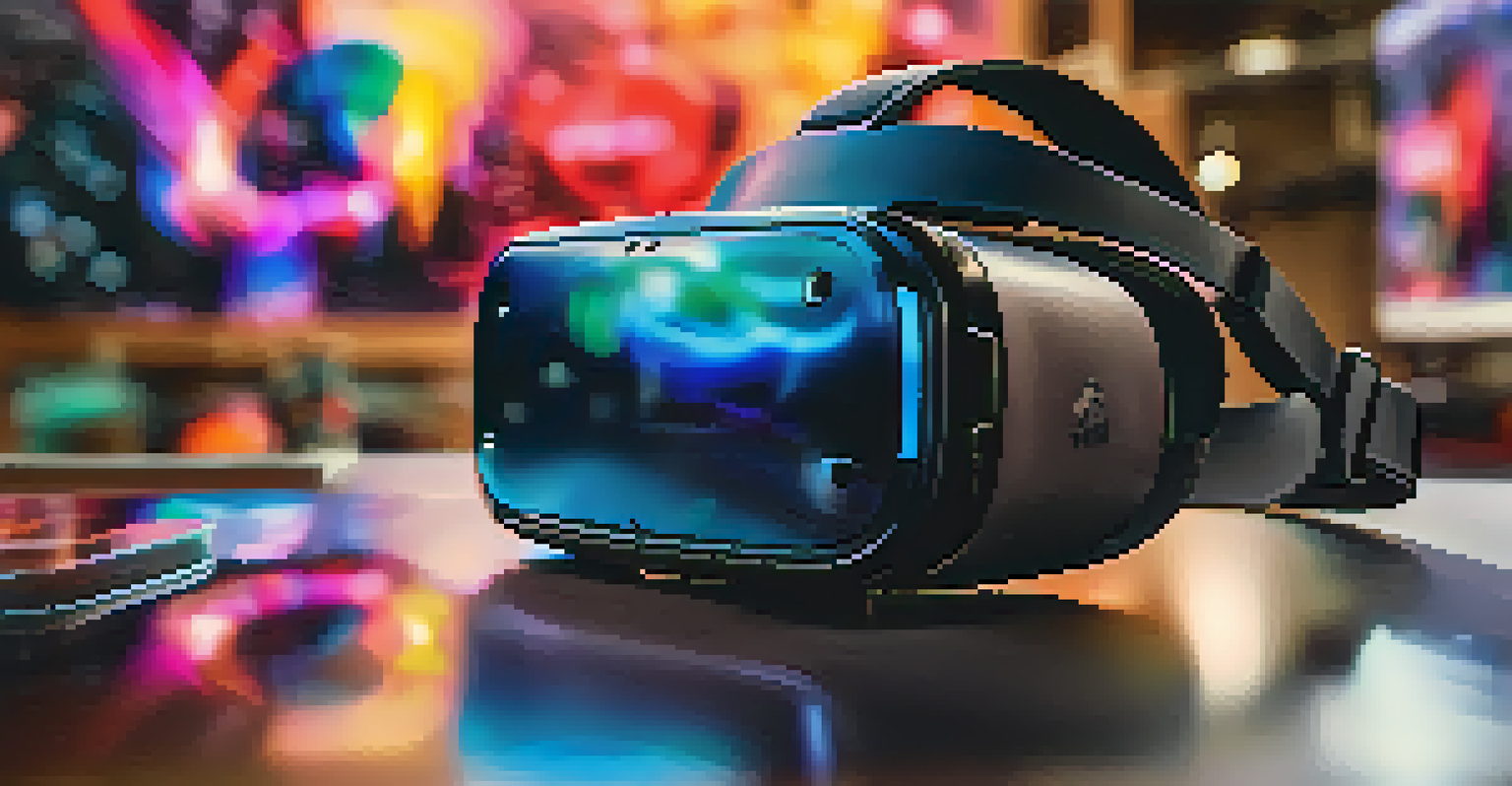Virtual Reality: The Next Big Thing in Hollywood Entertainment

Understanding Virtual Reality in Entertainment
Virtual reality (VR) immerses users in a completely digital environment, offering experiences that feel incredibly real. Unlike traditional film, where the audience is a passive observer, VR makes them an active participant in the story. Imagine stepping into the shoes of your favorite character and influencing the plot as you go; that’s the power of VR. This technology has the potential to revolutionize how we consume entertainment, shifting the focus from screen to self.
Virtual reality is not just a new way to play; it's a new way to tell stories.
In essence, VR creates a new dimension of storytelling, allowing filmmakers to explore narratives in ways never before possible. By engaging multiple senses, VR can evoke emotions and reactions that traditional formats may struggle to achieve. For instance, rather than just watching a horror movie, you can walk through a spooky mansion, heightening the thrill. As this technology evolves, it invites creators to think outside the box and challenge conventional storytelling methods.
However, the integration of VR into Hollywood is still in its infancy. While some productions have experimented with VR experiences, widespread adoption remains a work in progress. As audiences become more familiar with the technology, the potential for VR to become a staple in entertainment seems promising. The question isn't if VR will take off, but rather how quickly will it change the landscape of Hollywood.
The Impact of VR on Filmmaking Techniques
One of the most significant shifts VR brings to filmmaking is the need for new techniques and skill sets. Filmmakers must now think in three dimensions, considering how the viewer will interact with the space around them. This requires a deep understanding of spatial storytelling—an essential skill that can alter how scenes are constructed and shot. As a result, directors and cinematographers are exploring innovative ways to capture and present their stories.

Moreover, VR encourages collaboration among diverse creative talents, including game designers, animators, and sound engineers. This blend of expertise can lead to richer narratives and more polished productions. For example, a VR film might incorporate elements of gaming, such as player choice and interactivity, creating a multifaceted viewer experience. Filmmakers are challenged to push the boundaries of their craft, resulting in fresh and exciting content.
VR Transforms Storytelling
Virtual reality immerses users in narratives, allowing them to actively participate and influence the plot.
As the industry adapts, we’re likely to see traditional film techniques merging with VR to create hybrid forms of entertainment. This evolution will not only enhance storytelling but also attract a broader audience, including gamers and tech enthusiasts. In this way, VR could redefine the art of filmmaking, offering endless possibilities for creative expression.
Audience Engagement: A Whole New Level
One of the most exciting aspects of VR in Hollywood is its ability to engage audiences like never before. Instead of merely watching a story unfold, viewers can step into the narrative, making choices that affect the outcome. This level of interactivity can create a deeper emotional connection with the characters and the story, as participants feel their actions have real consequences. It’s like being a character in a video game but with the cinematic quality of a movie.
The future is already here — it's just not very evenly distributed.
Take, for instance, the wave of VR experiences tied to popular franchises. Fans of a blockbuster film can explore its universe, meet characters, and even take part in pivotal scenes. This kind of engagement is not just about entertainment; it fosters a community among fans who share similar experiences. This shared journey can lead to discussions, fan theories, and a dedicated following, breathing new life into franchise marketing.
As VR technology advances, the potential for more personalized experiences grows. Imagine watching a romantic movie and being able to choose your perspective, or a thriller where your choices determine the fate of the characters. This personalized approach could redefine how stories are told and consumed, making each viewing unique. With VR, Hollywood can cultivate a more invested and enthusiastic audience, paving the way for future innovations.
Challenges Facing VR Adoption in Hollywood
Despite its promise, the road to widespread VR adoption in Hollywood is fraught with challenges. One major hurdle is the cost of production. Creating high-quality VR content often requires substantial investment in technology, talent, and time. Smaller studios may struggle to compete with larger studios that have more resources, potentially limiting the diversity of VR content available to audiences. This financial barrier can stifle innovation and slow the growth of VR in the industry.
Another challenge is the learning curve associated with new technology. Filmmakers and studios must adapt to entirely new ways of working, which can be daunting. Training and education about VR production techniques are essential to ensure that creative professionals are equipped to navigate this landscape. Furthermore, there’s a need for industry-wide standards to ensure that VR content is accessible and enjoyable for all users.
New Filmmaking Techniques Required
Filmmakers must adapt to three-dimensional storytelling, collaborating with diverse talents to create innovative VR content.
Lastly, the audience's readiness to embrace VR plays a significant role in its success. While younger generations are increasingly tech-savvy, older audiences may be more resistant to change. Ensuring that VR experiences are intuitive and user-friendly will be vital in winning over skeptics. By addressing these challenges, Hollywood can create a more welcoming environment for VR, unlocking its full potential.
The Role of VR in Film Festivals and Events
Film festivals have always been a platform for innovation, and now, many are embracing VR as part of their offerings. Events like the Sundance Film Festival and Tribeca Film Festival have included dedicated VR sections, showcasing groundbreaking projects that push the boundaries of storytelling. These festivals provide filmmakers with an opportunity to present their work in a unique format, reaching audiences eager to explore the latest trends in entertainment.
By featuring VR content, festivals also help to legitimize the medium, demonstrating that it is not just a gimmick but a legitimate form of artistic expression. This exposure can attract industry attention, leading to potential collaborations and funding opportunities. Additionally, audiences can experience VR films firsthand, which can spark interest and enthusiasm for future projects. The immersive nature of VR can create buzz and excitement, making these events unforgettable.
As festivals continue to evolve, we may see more dedicated categories and awards for VR content. This recognition can encourage filmmakers to invest in VR projects and experiment with new ideas. By fostering a culture that celebrates VR, the industry can nurture the next generation of storytellers who will redefine what it means to create and consume entertainment.
The Future of VR in Hollywood: What's Next?
Looking ahead, the future of VR in Hollywood is brimming with potential. As technology continues to advance, we can expect even more sophisticated VR experiences that blur the line between reality and fiction. Enhanced graphics, improved motion tracking, and more intuitive interfaces will create immersive environments that feel more real than ever. This could transform not only how stories are told but also how audiences perceive and interact with them.
Moreover, the possibilities for cross-platform experiences are expanding. Imagine watching a VR film that connects to a mobile app, allowing users to explore the narrative further or even contribute to it. This interconnected approach can create a richer storytelling ecosystem, where fans can engage beyond the initial experience. Such innovations could also lead to new revenue streams for filmmakers and studios, as they find ways to monetize immersive content.
Engaging Audiences through Interactivity
VR enables viewers to make choices that affect story outcomes, fostering deeper emotional connections with the narrative.
Ultimately, the success of VR in Hollywood will hinge on collaboration among creators, technologists, and audiences. By sharing insights and exploring new ideas, the industry can continue to innovate and push the boundaries of entertainment. While challenges remain, the excitement surrounding VR offers a glimpse into a future where storytelling is more interactive, engaging, and transformative than ever before.
Conclusion: Embracing the VR Revolution
As we wrap up our exploration of virtual reality in Hollywood, it’s clear that this technology holds immense potential to reshape the entertainment landscape. From immersive storytelling to enhanced audience engagement, VR offers a fresh perspective that could redefine how we experience films. While there are challenges to overcome, the enthusiasm surrounding VR is palpable, and its integration into Hollywood seems inevitable.
The key will be to embrace this revolution with open minds and a willingness to adapt. Filmmakers, studios, and audiences alike must be willing to experiment, learn, and engage with this new medium. As we continue to navigate the evolving world of entertainment, it’s essential to foster a culture of innovation and creativity to ensure that VR reaches its full potential.

In conclusion, virtual reality is not just a passing trend; it represents a significant shift in the way stories are told and experienced. By welcoming this technology into Hollywood, we open the door to a new realm of possibilities that could captivate audiences for generations to come. The future is bright, and the VR revolution is just beginning.